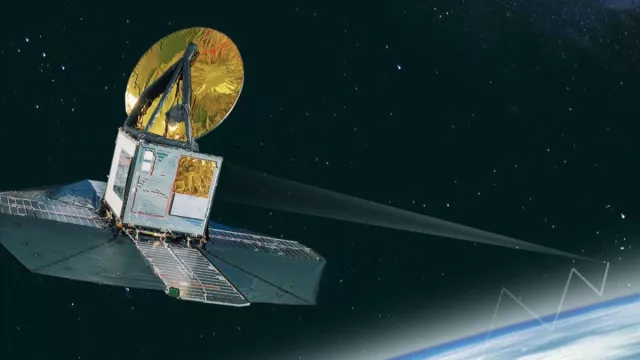Originally designed for a two-year mission to study Earth’s atmosphere and celestial bodies like newly forming stars, the small Odin satellite is still going strong years after launch.
Key information
| Mission | Study Earth’s atmosphere and celestial bodies like newly forming stars |
|---|---|
| Domain | Science |
| Launch date | 20 February 2001 |
| Partners | Swedish National Space Agency (Ex-SNSB, initiator), CSA, NSERC, Finnish Funding Agency For Innovation (TEKES), LATMOS (ex-Aeronomy Department), CNRM/Meteo France, OASU (ex-Observatoire de Bordeaux), Observatoire de Paris, ENS, IRAP (ex-CESR), LAM |
| Where | 600-km Sun-synchronous Earth orbit |
| Lifetime | Initially designed for 2 years but still operating nominally |
| Status | In operation |
Key figures
- 250 kg: satellite mass
- 2 m x 2 m x 3.8 m: satellite dimensions
- 2 instruments
- 7 contributing French laboratories and institutes
Key milestones
- 20 February 2001: Launch of Odin space telescope by Start-1
- Summer 2000: Flight model testing in Toulouse
Project in brief
Odin is a Swedish minisatellite developed in partnership with Canada, Finland and France. Launched in February 2001 by a Russian Start-1 vehicle, Odin spent six years devoting half of its observation time to studying the composition of Earth’s atmosphere and the other half to newly forming stars, interstellar clouds, galaxies and comets. Since 2007, the satellite has focused exclusively on aeronomy missions, with ESA funding climatology studies in particular.
The small satellite is carrying a Sub-Millimetre wave Radiometer (SMR), operating in tandem with an acousto-optical spectrometer (SAO), and an optical spectrometer (OSIRIS - Optical Spectrograph and InfraRed Imaging System). The SAO instrument was developed in France by the LAM astrophysics laboratory in Marseille as prime contractor, with the IRAP astrophysics and planetology research institute (formerly CESR) and the ARPEGES radioastronomy department at the Meudon observatory. With these instruments, Odin is able to detect the signature of key molecules such as water vapour, oxygen, ozone and carbon monoxide.
Odin’s aeronomy mission, meanwhile, has observed the geographic distribution of carbon monoxide and water vapour in our atmosphere, as well as the impact of polar vortices on the ozone layer. And in astronomy, it has precisely measured the amount of water vapour in the atmosphere of Mars and detected water in 10 comets and numerous galactic sources.
CNES’s role
CNES’s contribution to Odin covered:
- Supply of the SAO spectrometer developed by LAM as prime contractor with CESR and the ARPEGES radioastronomy department at the Meudon observatory
- Procurement from French manufacturers of Sun and star trackers and gyros
- Satellite attitude determination and control, specifically supplying a star catalogue for the star tracker and seconding an engineer from the agency’s Toulouse Space Centre to the project group in Sweden
- Satellite environmental testing at Intespace, under Swedish supervision
- telescope alignment tests at CESR in Toulouse
CNES was also involved with French laboratories in setting up a user ground component to validate the mission’s science data. This component mainly comprised:
- An aeronomy science data processing chain (MOLIERE), for which the algorithms were conceived by the Observatoire de Bordeaux and operationalized by Silogic. This chain rendered atmospheric molecule profiles (level 2 products)
- An astronomy data management and processing system, developed by Silogic, which ran on IT resources at the Toulouse Space Centre
Contacts
Head of Astronomy & Astrophysics
Philippe Laudet
E-mail: philippe.laudet at cnes.fr


